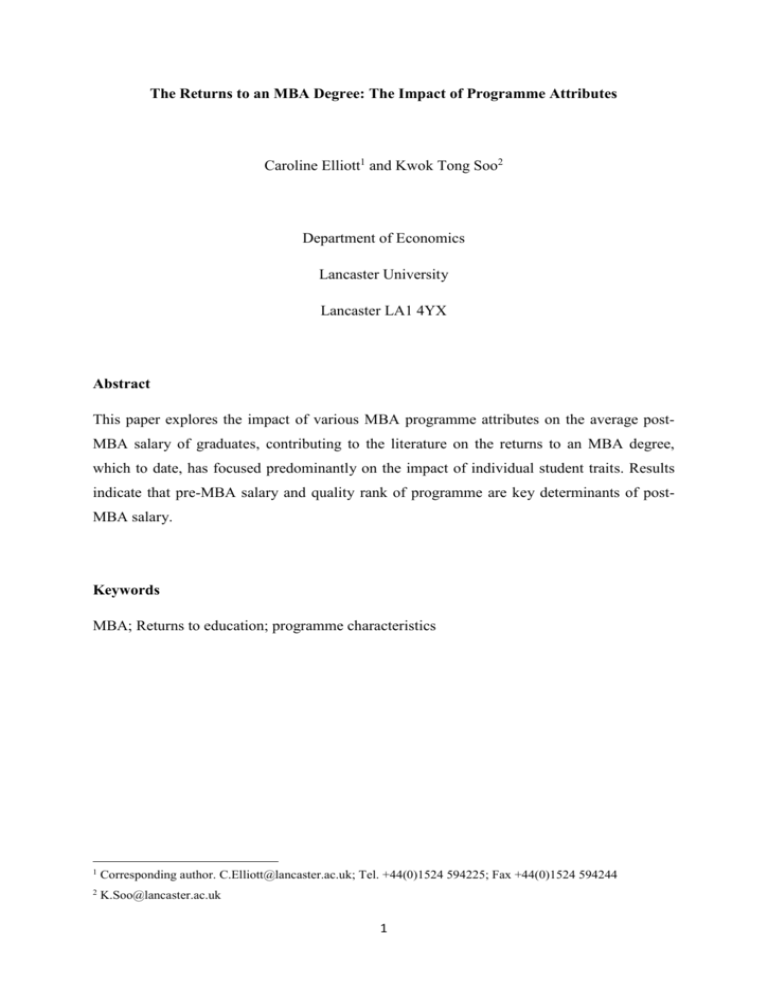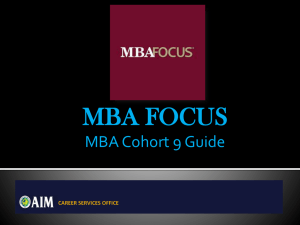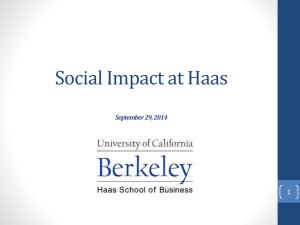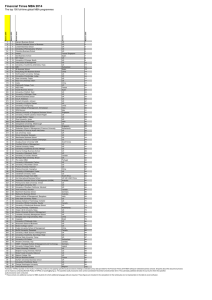The Impact of Programme Attributes
advertisement

The Returns to an MBA Degree: The Impact of Programme Attributes Caroline Elliott1 and Kwok Tong Soo2 Department of Economics Lancaster University Lancaster LA1 4YX Abstract This paper explores the impact of various MBA programme attributes on the average postMBA salary of graduates, contributing to the literature on the returns to an MBA degree, which to date, has focused predominantly on the impact of individual student traits. Results indicate that pre-MBA salary and quality rank of programme are key determinants of postMBA salary. Keywords MBA; Returns to education; programme characteristics 1 Corresponding author. C.Elliott@lancaster.ac.uk; Tel. +44(0)1524 594225; Fax +44(0)1524 594244 2 K.Soo@lancaster.ac.uk 1 The Returns to an MBA Degree: The Impact of Programme Attributes 1. Introduction This paper explores the impact of various MBA programme attributes on the average postMBA salary of graduates. An extensive economics literature considers factors determining the returns to various levels of education, including a number of papers focusing on the factors influencing returns to an MBA degree, stretching back to Reder (1978). More recently, Arcidiacono et al. (2008) and Grove and Hussey (2011a) estimate the financial returns of an MBA, with Grove and Hussey (2011b) considering school and individual factors impacting on returns to an MBA. However, to date the literature focuses predominantly on the impact of individual student characteristics. While Grove and Hussey (2011b) and Hussey (2011) consider programme factors, their analysis of such factors is limited to the type of MBA undertaken, i.e. full-time; part-time; executive; programme specialisms; and whether a programme is in the top 10 or 25 US News rankings. Studies of the salary returns to a full-time MBA qualification are particularly valuable, given not only the premium fees typically associated with these programmes, but also the opportunity cost of not working while studying for the degree. The lack of attention to the impact of programme characteristics may partly reflect a paucity of data; the only data used to date being individual alumnus survey data collated by the Graduate Management Admissions Council (GMAC). Results below use data from a newly constructed dataset, using institution level data from the Which MBA Guide. Whilst the use of institution level data means that we lose some of the richness of the individual level data from GMAC, our dataset provides information on variables such as university and programme accreditations, as well as published programme rankings. Results are likely to be of value not only to prospective students when considering an MBA programme, but also to university policy makers. Results shed light on the determinants of post-MBA starting salaries, but also the programme attributes that maybe do not have the impact expected. 2. Data and Methodology Data are from successive editions of the Which MBA Guide, published by The Economist. Some data in the Guide are collected directly from each institution, for example data on fees, staff and student numbers, accreditations. However, since 1993, alumni have also been surveyed and aggregated responses are reported, allowing us to use variables that reflect 2 alumni views of the programmes undertaken. The Which MBA Guide has produced an overall ranking of the top MBA programmes since the 2002 edition of the Guide. It consists of 21 components; Ridgers (2009) has details of the construction of the overall ranking. All monetary values are converted into US dollars in real terms using the year-average exchange rates and Consumer Price Index of each country. Table 1: Descriptive Statistics Variable Post-MBA salary Average age Work experience Average GMAT score Which MBA rank Pre-MBA salary % Women students % Foreign students AACSB AMBA EQUIS % faculty with PhD Alumni faculty evaluation Faculty per student Alumni facilities evaluation Alumni careers service evaluation Alumni programme evaluation Alumni peers evaluation US Sample Mean Std. Dev. 71329 8834 27.76 0.948 4.610 0.766 668 3.27 45.5 27.3 44499 9524 0.303 0.053 0.374 0.140 0.971 0.168 0.019 0.138 0.051 0.221 0.937 0.084 4.443 0.196 0.593 0.417 4.343 0.260 3.748 0.418 4.292 0.218 4.298 0.307 Non-US Sample Mean Std. Dev. 80281 24898 29.67 1.712 6.325 1.711 635 3.70 53.8 29.2 49100 17664 0.315 0.090 0.682 0.208 0.559 0.497 0.742 0.438 0.756 0.430 0.883 0.126 4.163 0.247 0.899 0.676 4.173 0.348 3.451 0.449 4.156 0.249 4.121 0.321 The sample is an unbalanced panel, covering seven years from 2004 to 2010 and 606 observations from 115 universities, with 311 observations from 52 universities in a sample restricted to US universities. Table 1 provides basic descriptive statistics, dividing the sample into US and non-US programmes. As the data are from the Which MBA Guide, observations relate to MBA programmes identified by that publication as the best quality MBA programmes, which since 2002, the guide ranks as amongst the top 100 in the world. Except for the percentage of women students, there are statistically significant differences between US and non-US programmes in all variables. Compared to non-US universities, US universities occupy lower ranks in the Which MBA Guide (indicating higher quality), and have younger students with higher average GMAT scores and fewer years of work 3 experience. Both pre- and post-MBA salaries are lower for students from US programmes than from non-US programmes. We estimate Mincer (1974) type equations of post-MBA salaries as a function of pre-MBA salaries, age, work experience, average GMAT score, the rank of the MBA programme, and other covariates. These variables capture the human capital of MBA holders; in particular, the inclusion of pre-MBA salaries helps to capture aspects of workplace ability that are not captured by measures such as GMAT scores. Apart from age and work experience, all nondichotomous variables are in natural logs. Since the data is a panel, we use fixed-effects estimation including a full set of year and programme fixed effects, so the coefficients are estimated based on changes in the variables over time within each programme, and all timeinvariant programme-specific effects are swept out by the fixed effects. 3. Results Table 2 presents the results for all universities in the sample. Column (1) reports the baseline specification; columns (2) to (6) add additional covariates. As expected, higher post-MBA salaries are associated with higher pre-MBA salaries and having attended a lower ranked (higher quality) university, while it may pay to study for an MBA at a younger age 3. Of particular note are the variables that do not seem to impact significantly on the financial returns to an MBA degree. These include the average GMAT scores of students, the accreditations of a university, and the extent of previous work experience. The value of university careers services is also questioned as there may be a significant, negative relationship between alumni evaluations of careers services and post-MBA salaries. Table 3 shows that dividing the sample to US and non-US universities yields additional results. Most significantly, the negative relationship between alumni perceptions of careers services and post-MBA salaries holds only for the non-US sample. It may be that the older students in this sample may already have wider business networks and so have less need for careers services. University ranks and pre-MBA salaries continue to be highly significant predictors of post-MBA salaries in both US and non-US samples. 3 Squared terms of age and work experience never have any significant effect on the results. Although age and work experience are highly correlated (correlation > 0.8), including both variables separately does not change rhe results. Including age and work experience in natural logs also yields similar results to those reported. 4 Table 2: Regression Results Dep Var Average age Work experience Ln(average GMAT score) Ln(Which MBA rank) Ln(pre-MBA salary) Ln(Post-MBA salary) (1) -0.012 (0.006)* 0.004 (0.008) 0.260 (0.316) -0.082 (0.017)*** 0.347 (0.056)*** Ln(% female students) Ln(% foreign students) (2) -0.012 (0.007)* 0.004 (0.008) 0.261 (0.321) -0.082 (0.017)*** 0.349 (0.056)*** 0.002 (0.025) 0.016 (0.016) AACSB (3) -0.012 (0.006)* 0.004 (0.008) 0.265 (0.319) -0.083 (0.017)*** 0.344 (0.056)*** (5) -0.013 (0.006)** 0.007 (0.007) 0.261 (0.263) -0.103 (0.019)*** 0.351 (0.052)*** 0.002 (0.039) -0.066 (0.093) 0.003 (0.029) AMBA EQUIS Ln(% faculty with PhD) Ln(Alumni faculty evaluation) Ln(faculty per student) Ln(Alumni facilities evaluation) Ln(Alumni careers service evaluation) Ln(Alumni programme evaluation) Ln(Alumni peers evaluation) R2 N (4) -0.012 (0.006)** 0.007 (0.008) 0.254 (0.307) -0.092 (0.019)*** 0.350 (0.053)*** 0.022 (0.042) -0.590 (0.178)*** -0.003 (0.015) 0.41 606 0.41 601 0.41 606 0.43 603 -0.266 (0.149)* -0.215 (0.082)** -0.092 (0.220) 0.048 (0.209) 0.45 606 (6) -0.014 (0.005)** 0.008 (0.007) 0.258 (0.266) -0.104 (0.021)*** 0.349 (0.050)*** 0.013 (0.022) 0.010 (0.015) 0.002 (0.041) -0.089 (0.080) 0.011 (0.026) 0.032 (0.044) -0.424 (0.248)* -0.005 (0.015) -0.205 (0.151) -0.222 (0.083)*** 0.163 (0.275) 0.079 (0.202) 0.46 598 Notes:* significant at 10%; ** significant at 5%; *** significant at 1%. Heteroskedastic-robust standard errors reported in parentheses. All regressions include university and year fixed effects. 5 Table 3: US and non-US universities (1) (2) US sample Non-US sample Ln(post-MBA salary) -0.001 -0.015 (0.005) (0.009)* 0.012 0.011 (0.007) (0.011) 0.138 0.295 (0.210) (0.261) -0.022 -0.164 (0.010)** (0.032)*** 0.068 0.455 (0.031)** (0.046)*** 0.036 0.003 (0.020)* (0.026) 0.005 -0.026 (0.009) (0.029) -0.201 0.041 (0.021)*** (0.034) 0.048 -0.080 (0.019)** (0.073) 0.002 -0.006 (0.016) (0.037) 0.000 0.063 (0.017) (0.093) -0.204 -0.137 (0.253) (0.348) 0.003 -0.008 (0.011) (0.021) 0.053 -0.319 (0.090) (0.189)* -0.045 -0.306 (0.054) (0.104)*** -0.020 -0.023 (0.232) (0.352) 0.173 0.070 (0.123) (0.231) 0.35 0.63 308 290 Dependent Variable Average age Work experience Ln(average GMAT score) Ln(Which MBA rank) Ln(pre-MBA salary) Ln(% female students) Ln(% foreign students) AACSB AMBA EQUIS Ln(% faculty with PhD) Ln(Alumni faculty evaluation) Ln(faculty per student) Ln(Alumni facilities evaluation) Ln(Alumni careers service evaluation) Ln(Alumni programme evaluation) Ln(Alumni peers evaluation) R2 N Notes:* significant at 10%; ** significant at 5%; *** significant at 1%. Heteroskedastic-robust standard errors reported in parentheses. All regressions include university and year fixed effects. 6 It was hypothesized that employers may offer higher salaries to graduates from high ranking programmes, paying less attention to the particular rank of a programme. Hence in line with the approach used by Grove and Hussey (2011a), regressions were rerun instead using dummy variables to indicate whether an institution was ranked 1-10, or 11-25 in the Which MBA guide. We found results that were similar to those reported in Tables 2 and 3. A further concern was possible measurement error in the pre-MBA salaries, which may result in attenuation bias in the corresponding coefficient4. Experimenting with reverse regressions and comparing first-differences with fixed effects estimates (Hausman (2001), Grilliches and Hausman (1986)) suggested that measurement error may indeed be present in the data. In light of this our results may be viewed as a lower bound on the effect of pre-MBA salaries on post-MBA ones. 4. Conclusions This paper explores the programme attributes impacting on the financial returns to an MBA. Results indicate that pre-MBA salary and quality of programme as measured by Which MBA Guide rankings are key determinants of post-MBA salary. Professional accreditation and alumni evaluations have no significant impact or may even have a negative impact on postMBA salary. References Arcidiacono, P., Cooley, J., Hussey, A., 2008. The economic returns to an MBA. International Economic Review. 49, 873-899. Griliches, Z., Hausman, J., 1986. Errors in variables in panel data. Journal of Econometrics. 31, 93-118. Grove, W.A., Hussey, A., 2011a. Returns to field of study versus school quality: MBA selection on observed and unobserved heterogeneity. Economic Inquiry. 49, 730-749. Grove, W.A., Hussey, A., 2011b. Returns to MBA quality: pecuniary and non-pecuniary returns to peers, faculty, and institution quality. University of Memphis Working Paper. Hausman, J., 2001. Mismeasured variables in econometric analysis: Problems from the right and problems from the left. Journal of Economic Perspectives. 15, 57-67. 4 Measurement error in post-MBA salaries would inflate the standard error of the estimates but will not bias the coefficients. 7 Hussey, A., 2011. Human capital augmentation versus the signaling value of MBA education. University of Memphis Working Paper. Mincer, J.A., 1974. Schooling, experience, and earnings, Columbia University Press, New York. Reder, M.W., 1978. An analysis of a small, closely observed labor market: starting salaries for University of Chicago MBAs. Journal of Business. 51, 263-297. Ridgers, B., (ed.) 2009. Which MBA? 21st Edition, The Economist Newspaper, London. 8







